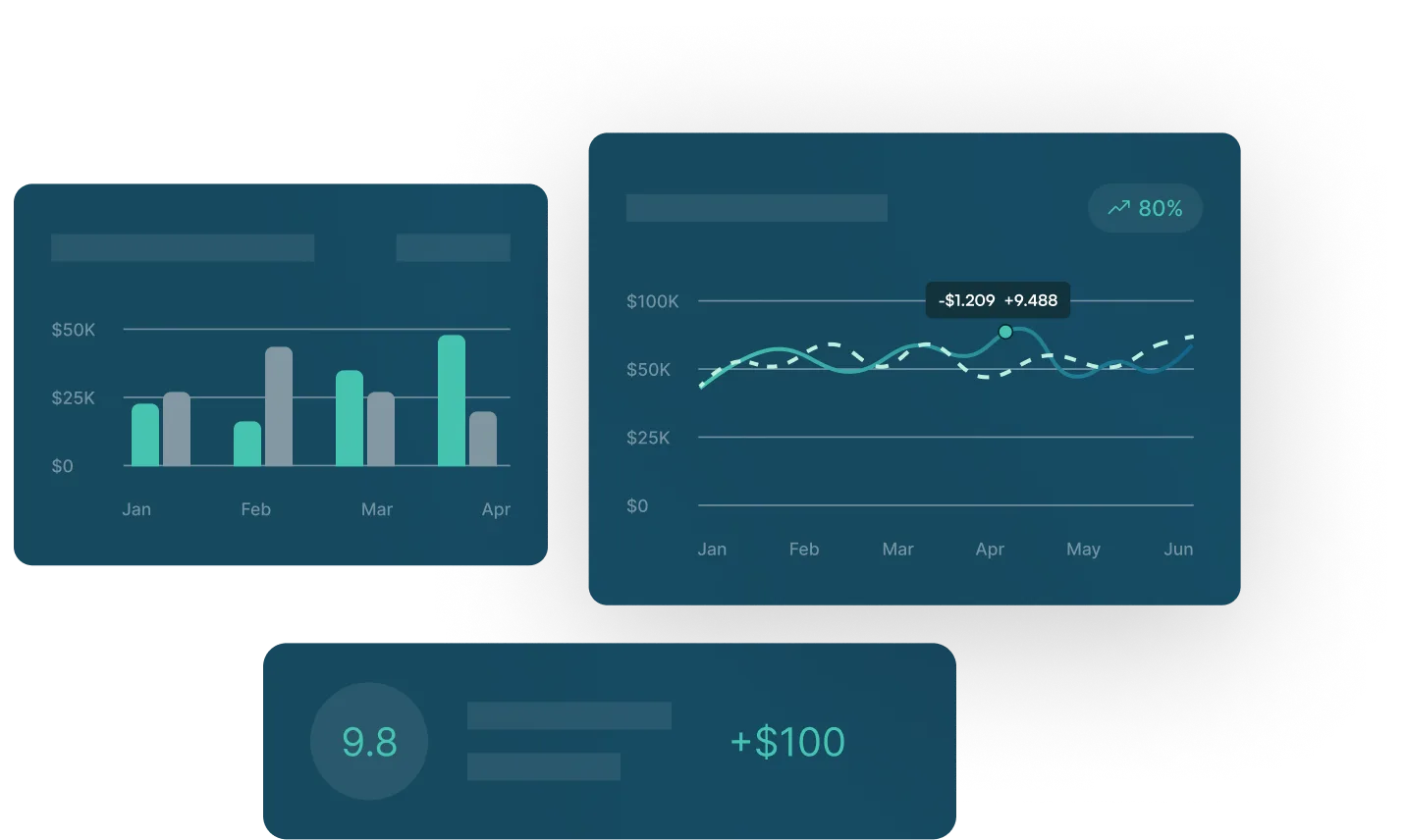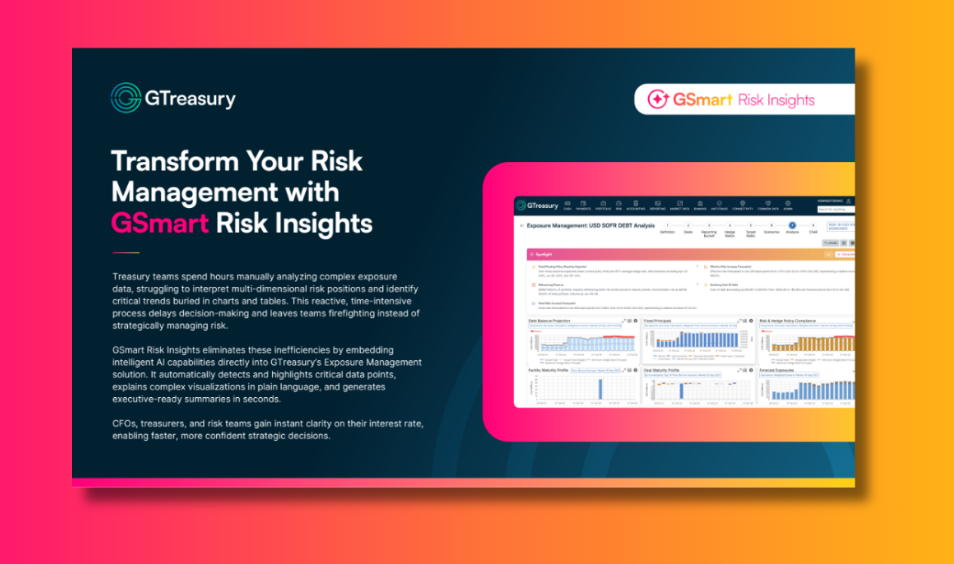What is Currency Risk Management?
.jpg)
.jpg)
Also known as foreign exchange (FX) risk management, currency risk management is a strategic priority for treasury teams navigating global markets
When dealing with global sales, international supply chains, or cross-border investments, companies can become exposed to changes in the value of different currencies. These fluctuations can have a significant impact on revenue and profitability, with even small changes in exchange rates translating into large financial gains or losses.
Why Currency Risk Management Matters
An effective currency risk management strategy requires a mix of financial instruments and close monitoring of exposures. By doing so, businesses can reduce volatility, protect margins, and gain greater financial predictability in a global economy.
For companies that operate across borders, foreign currency exposure is unavoidable. A single unfavorable currency swing can turn a profitable contract into a loss, especially in industries with tight margins or long payment cycles.
Additionally, as stakeholders and regulators place greater emphasis on financial transparency and risk mitigation, proactively managing currency risk is no longer optional. As global volatility increases, investors, auditors, and boards are demanding greater accountability and visibility into FX risk.
To effectively navigate this landscape, it's essential to understand the different types of currency risk can have an impact on financial performance.
Major Types of Currency Risk, and Why They Matter
Not all currency exposures affect financials in the same way. Some types of currency risk impact cash flow directly, while others influence financial reporting or long-term competitiveness.
By understanding which types of exposure are most relevant to their operations, treasury teams can tailor their hedging strategies more precisely.
Transaction Risk
Transaction risk arises when a company commits a financial obligation in a foreign currency. This typically includes payments for goods, services, or debt that are settled in a currency different from the company’s functional currency.
Because exchange rates fluctuate between the time a transaction is initiated and when it is settled, companies can end up paying more or receiving less than expected.
This type of risk directly affects cash flow and profitability and is most common in companies engaged in international trade.
Translation Risk
Translation risk affects the way foreign assets, revenues, and expenses are represented on financial statements. It occurs when subsidiaries operate in different currencies than the parent company, requiring periodic consolidation into the reporting currency.
Although translation risk doesn’t impact actual cash flow, it can influence reported earnings and balance sheet valuations. For example, if a U.S. company owns a European subsidiary, a weakening euro may reduce the subsidiary’s earnings when translated into dollars.
This can distort financial performance and investor perception, even if business operations remain stable.
Economic Risk
Economic risk refers to the long-term impact that currency fluctuations can have on a company’s market value. Unlike transaction or translation risk, economic risk is broader and harder to quantify, as it affects the company’s ability to compete in global markets over time.
Economic risk can influence strategic decisions, such as where to source materials or invest in expansion. Companies can mitigate this type of risk by diversifying their supply chains or establishing operations in multiple markets. For example, a multinational that sources goods in one currency and sells in another may find margins squeezed if long-term shifts make sourcing more expensive.
Common Challenges in Currency Risk Management
Managing currency risk can be complex, and even well-resourced treasury teams face unique challenges. Here’s a look at some of the most common hurdles treasurers deal with when managing currency risk:
- Visibility: Many organizations lack a clear, real-time view of their global exposures. Without accurate data, it becomes difficult to assess risk levels or take timely action.
- Volatility: Exchange rates can shift rapidly in response to a changing economy. When market volatility hits, the added unpredictability makes it difficult to plan ahead.
- Connectivity: Effective currency risk management requires input from multiple departments. Misalignment between various teams or inputs can result in missed hedging opportunities or duplicated efforts.
To overcome these challenges, treasury teams need three things, accurate data, proactive planning, and cross-functional coordination.
Currency Risk Management Strategies That Work
When managing currency risk effectively, companies typically use a mix of financial instruments and operational tactics based on their specific exposures. The most common strategies include financial hedging, natural hedging, and operational adjustments.
- Financial hedging uses tools like forward contracts, and swaps to lock in exchange rates or cap potential losses. This approach is especially effective for managing known transaction exposures with clear timelines.
- Natural hedging reduces risk by aligning foreign currency inflows and outflows. For example, a company earning revenue in euros may also pay suppliers or operate facilities in euros to minimize the need for currency conversion.
- Operational strategies include invoicing in the company’s home currency, adjusting pricing to reflect FX shifts, or locating production closer to key markets. These approaches can reduce exposure over time and improve predictability.
Treasury teams combine these tactics within a broader risk policy that includes setting exposure limits and centralizing FX management. The goal is not to eliminate risk entirely, but to reduce uncertainty and protect financial stability.
Tools and Technologies for Currency Risk Management
Modern treasury platforms like GTreasury help streamline currency risk management.
With centralized data, automated workflows, and improved visibility, teams get real-time insights and the ability to make more informed decisions.
With the right tools, companies can reduce the chance of manual errors and respond quickly to market changes, making for a stronger and more resilient currency risk strategy. These technologies empower treasury teams to move from reactive to proactive currency risk management.
What is Currency Risk Management?
Also known as foreign exchange (FX) risk management, currency risk management is a strategic priority for treasury teams navigating global markets
When dealing with global sales, international supply chains, or cross-border investments, companies can become exposed to changes in the value of different currencies. These fluctuations can have a significant impact on revenue and profitability, with even small changes in exchange rates translating into large financial gains or losses.
Why Currency Risk Management Matters
An effective currency risk management strategy requires a mix of financial instruments and close monitoring of exposures. By doing so, businesses can reduce volatility, protect margins, and gain greater financial predictability in a global economy.
For companies that operate across borders, foreign currency exposure is unavoidable. A single unfavorable currency swing can turn a profitable contract into a loss, especially in industries with tight margins or long payment cycles.
Additionally, as stakeholders and regulators place greater emphasis on financial transparency and risk mitigation, proactively managing currency risk is no longer optional. As global volatility increases, investors, auditors, and boards are demanding greater accountability and visibility into FX risk.
To effectively navigate this landscape, it's essential to understand the different types of currency risk can have an impact on financial performance.
Major Types of Currency Risk, and Why They Matter
Not all currency exposures affect financials in the same way. Some types of currency risk impact cash flow directly, while others influence financial reporting or long-term competitiveness.
By understanding which types of exposure are most relevant to their operations, treasury teams can tailor their hedging strategies more precisely.
Transaction Risk
Transaction risk arises when a company commits a financial obligation in a foreign currency. This typically includes payments for goods, services, or debt that are settled in a currency different from the company’s functional currency.
Because exchange rates fluctuate between the time a transaction is initiated and when it is settled, companies can end up paying more or receiving less than expected.
This type of risk directly affects cash flow and profitability and is most common in companies engaged in international trade.
Translation Risk
Translation risk affects the way foreign assets, revenues, and expenses are represented on financial statements. It occurs when subsidiaries operate in different currencies than the parent company, requiring periodic consolidation into the reporting currency.
Although translation risk doesn’t impact actual cash flow, it can influence reported earnings and balance sheet valuations. For example, if a U.S. company owns a European subsidiary, a weakening euro may reduce the subsidiary’s earnings when translated into dollars.
This can distort financial performance and investor perception, even if business operations remain stable.
Economic Risk
Economic risk refers to the long-term impact that currency fluctuations can have on a company’s market value. Unlike transaction or translation risk, economic risk is broader and harder to quantify, as it affects the company’s ability to compete in global markets over time.
Economic risk can influence strategic decisions, such as where to source materials or invest in expansion. Companies can mitigate this type of risk by diversifying their supply chains or establishing operations in multiple markets. For example, a multinational that sources goods in one currency and sells in another may find margins squeezed if long-term shifts make sourcing more expensive.
Common Challenges in Currency Risk Management
Managing currency risk can be complex, and even well-resourced treasury teams face unique challenges. Here’s a look at some of the most common hurdles treasurers deal with when managing currency risk:
- Visibility: Many organizations lack a clear, real-time view of their global exposures. Without accurate data, it becomes difficult to assess risk levels or take timely action.
- Volatility: Exchange rates can shift rapidly in response to a changing economy. When market volatility hits, the added unpredictability makes it difficult to plan ahead.
- Connectivity: Effective currency risk management requires input from multiple departments. Misalignment between various teams or inputs can result in missed hedging opportunities or duplicated efforts.
To overcome these challenges, treasury teams need three things, accurate data, proactive planning, and cross-functional coordination.
Currency Risk Management Strategies That Work
When managing currency risk effectively, companies typically use a mix of financial instruments and operational tactics based on their specific exposures. The most common strategies include financial hedging, natural hedging, and operational adjustments.
- Financial hedging uses tools like forward contracts, and swaps to lock in exchange rates or cap potential losses. This approach is especially effective for managing known transaction exposures with clear timelines.
- Natural hedging reduces risk by aligning foreign currency inflows and outflows. For example, a company earning revenue in euros may also pay suppliers or operate facilities in euros to minimize the need for currency conversion.
- Operational strategies include invoicing in the company’s home currency, adjusting pricing to reflect FX shifts, or locating production closer to key markets. These approaches can reduce exposure over time and improve predictability.
Treasury teams combine these tactics within a broader risk policy that includes setting exposure limits and centralizing FX management. The goal is not to eliminate risk entirely, but to reduce uncertainty and protect financial stability.
Tools and Technologies for Currency Risk Management
Modern treasury platforms like GTreasury help streamline currency risk management.
With centralized data, automated workflows, and improved visibility, teams get real-time insights and the ability to make more informed decisions.
With the right tools, companies can reduce the chance of manual errors and respond quickly to market changes, making for a stronger and more resilient currency risk strategy. These technologies empower treasury teams to move from reactive to proactive currency risk management.
.jpg)
See GTreasury in Action
Get connected with supportive experts, comprehensive solutions, and untapped possibility today.






























.png)





.png)
.png)







.png)












.jpeg)

.jpeg)


.jpeg)







.jpeg)

.jpeg)





.jpeg)


.jpeg)

.jpeg)








.jpeg)


.jpg)






.jpg)





